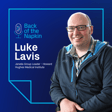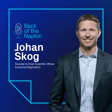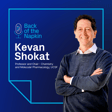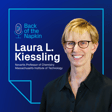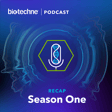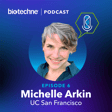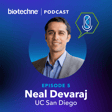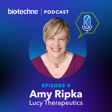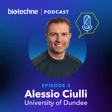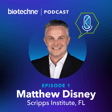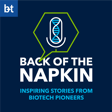Become a Creator today!Start creating today - Share your story with the world!
Start for free
00:00:00
00:00:01

Jennifer Petter: Opportunities for RNA-Targeted Therapeutics
Jennifer Petter is the founder and Chief Innovation Officer at Arrakis Therapeutics. Here she discusses the moments that led up to the founding of a successful biotech company built on a remarkable new approach in drug discovery: RNA-targeting small molecules. This back of the napkin conversation covers the standout moments in Jen’s career as well as some insightful perspectives into the future of drug discovery.
Arrakis Therapeutics Website: https://arrakistx.com/
Transcript
Serendipitous Discoveries and Innovation
00:00:03
Speaker
A discovery is said to be an accident meeting a prepared mind, but every story behind a discovery is different.
00:00:11
Speaker
Perhaps the idea is conceived in a light-bulb moment, or a brainstorming session, or captured in scribblings on the back of a napkin.
Introduction to 'Innovation Corner' with Alex Maloney
00:00:19
Speaker
Here, we introduce you to scientific pioneers, taking you beyond their publication, and into Innovation Corner to hear the untold stories behind their discoveries. This podcast is brought to you by Biotech, and I'm your host, Alex Maloney.
Jennifer Better's Journey: Academia to Biotech
00:00:38
Speaker
Our guest today is Jennifer Better. Jen is someone who's paved her way through a career in academia, biotech and pharma, working her way to the very top of the game where she now sits as founder and chief innovation officer at Arrakis Therapeutics. Jen's a medicinal chemist by background and you'll hear her described as one of the best in the business.
00:01:01
Speaker
Now, well outside the lab, Jen has formed an all-star team, Arrakis, focused on a new problem. That is, targeting RNA with small molecules.
00:01:12
Speaker
So, if you heard the previous episode with Matt Disney, you were probably like me, enormously inspired by the proof of concept work Matt has done, showing that RNA can be targeted with small molecules. Well, Jen was too, back in 2015, where she came across the trailblazing work from Matt and others like Kevin Weeks at a conference.
00:01:33
Speaker
Energised by this new area, Jen stepped up to take this modality to the next level and started working on irony targeting small molecule drugs. Now with Jen talks, people listen. She's hugely charismatic, knowledgeable, talented, thoughtful and was such a fantastic guest on the podcast.
Founding Arrakis Therapeutics and RNA Targeting
00:01:53
Speaker
We discuss lots here, like Jen's time and early successes in biotech and pharma. The story behind Arrakis, that's the company, not the sci-fi planet, although that did come into it a little too. We spoke about the processes of starting a company and getting this off the ground, and also what Jen thinks the biggest advancements in drug discovery will be in the next 10 years. On top of this, Jen also gives a very open insight into a big transition she formally announced back in 2018.
00:02:23
Speaker
This was that she was a transgender woman and would no longer be known as Russell Petter. She would now have the pronoun she her and be Jennifer. So let's get to it. Welcome to Back of the Napkin.
Personal Passions and Early Scientific Inspirations
00:02:41
Speaker
Okay, Jennifer Petter. Great to have you here. Welcome to the podcast.
00:02:46
Speaker
Thank you for having me. Okay, now, Jen, this is a science podcast, but before we dive into this, I've got to ask you something that I read in a CNN article about your dogs. And that's that you got 17 dogs, 16 of which are Border Collies, is that right? So close. So I've managed to get the number down to 13. And they're not strictly speaking Border Collies, they're like regular Lassie Collies.
00:03:15
Speaker
And so, yes, and I show them, I breed them. It's been a consuming passion for the entirety of my life. And so, and it, as I occasionally said to people, it keeps me out of trouble and off the streets.
00:03:34
Speaker
So my parents, they always had border collies. So these were border collies. I know. They're smart dogs. Yeah. Yeah. I say I was raised around border collies, but I think it's sometimes more appropriate to say I was raised by border collies. They were that smart.
00:03:49
Speaker
But yeah, anyway, okay, this isn't a dog podcast, so let's get on to some science. So it'd be good then to lay the foundations for this discussion about your journey through science. So to begin with, then what was the moment that you got into science? Was there a catalyst here? And go back as far as you want.
00:04:14
Speaker
It's hard to say, but I can say that I, you know, as a very young child, you know, science things were very motivating for me. So I remember years ago when I was about four or so, my father was a chaplain in the Navy and was stationed in San Diego. And my parents took me up the hill to the Palomar, Mount Palomar Observatory.
00:04:40
Speaker
whether it was this brand new 200-inch reflector telescope, just gigantic. And you go into this thing, and it lets us say it made an impression.
00:04:52
Speaker
And also, that was the point at which Disneyland was open. Disney World was still a twinkle in Walt Disney's eye. And the monorail was there, so futuristic. And again, truth be told, when I wasn't able to go to the monorail a second time, I think I had a meltdown right there at Disneyland. So even at a very young age, things about the future, I think that maybe some of that came from
00:05:17
Speaker
I was kind of a Sputnik child. I was born in 56 and Sputnik went up in 57. And the whole country was abuzz about this. I think it made an impression on me.
Choosing Chemistry and Academic Path
00:05:27
Speaker
So then when you, I guess, formally start your scientific career, you go to college and you get an A.B. in chemistry. So what made you kind of hone in on chemistry?
00:05:45
Speaker
So the truth was I didn't like chemistry. I wanted to do molecular biology, but I'd heard that the teaching in the biology department there was not so exciting, and that you need to learn a lot of chemistry anyway. So I decided to suck it up and just double down on the chemistry, which had a good teaching reputation. But then I got into organic chemistry.
00:06:14
Speaker
just had a revelation. Because it wasn't as mathematical as physics, which had captivated me as a kid. But by the fourth semester of calculus, I was like, done. It stopped being easy.
00:06:29
Speaker
And biology was a huge amount of memorization, which actually was not opposed, so I think that's a perfect, people knock that, but I actually think that's a perfectly reasonable pathway. You gotta know stuff and reach some critical mass, but I was struggling with that. Whereas chemistry was that, particularly organic chemistry is that nice sort of middle ground. It certainly had the sort of intense logic of the physical sciences, but also this sort of mass of knowledge that you applied it to.
00:06:55
Speaker
And it's also very pictorial graphic and aesthetic, which definitely worked for me. So I really found myself literally in a course in college. I made that choice. Yeah. So it must have made an impression for you to then go on and do a PhD in chemistry. So where did you do that? I went to Duke, Duke University. So I went to Dartmouth for college and then went to Duke University.
00:07:24
Speaker
I've done some undergraduate research and really enjoyed that. In fact, I enjoyed the research more than I enjoyed the courses. And then at Duke, I got into a great group with Ned Porter, who was at Duke at the time. And then you continued a career in academia for some time doing a postdoc, is that right? Yeah.
00:07:50
Speaker
I got some nice fellowships and ended up going to Columbia University to work for Ron Breslow. In the 80s, Columbia was the absolute top place in the world to do organic chemistry, so I was very fortunate to be able to go there.
00:08:05
Speaker
and kind of measure yourself against the best. And so I had a great time there and then managed to, because I was at that institution, I managed to pull in an academic job that was pretty promising. But then you transitioned over to industry in 91. So what caused this move?
Industry Experience and Career Transitions
00:08:32
Speaker
In academics, it is up or out, honey. And I didn't get promoted. So I got plenty of money. I was doing very well on getting funding in. But translating that funding into papers, I don't think I quite appreciated the importance of what we now call the minimum publishable unit, which I might have wanted to explore that a little bit more.
00:09:02
Speaker
So in some ways, maybe I absorbed too much of what my mentors had, which was that you wait until you've got really a great story and publish this great paper, which is not a timing plan that works well for an assistant professor. So I didn't get promoted. And the academic opportunities at other institutions that were apparent to me
00:09:24
Speaker
just didn't look great. So I ended up finding a job at Sandos Pharmaceuticals, which of course became part of Novartis when they merged with Siva and really had a blast. So, you know, it's one of these things where, I'll tell you, at the time I wanted to be promoted desperately and it was tragic that I didn't get promoted, although, but in retrospect, awesome.
00:09:50
Speaker
Yeah, well, you know, we can certainly look back now and say that. So at the time then, when you go into that role at Sandoz, did you kind of sit down and write a new plan and say, okay, well, this is my journey to the top. No, no.
00:10:09
Speaker
There's never been a plan. I mean, as an academic, the plan was get promoted, become a famous scientist, and that was kind of it. That was the plan. And in industry, when I was at Sandoz, I was too early on even to know enough about an industrial path, even to write a plan, were I a plan writer, which I frankly tend not to be.
00:10:36
Speaker
Rather, I took a very different approach. So first of all, when you come out of academics, everyone has this view that you're very smart and you have this glorious position. You're going to be kind of, well, difficult when you move in the industry. I very strove not to be difficult.
00:10:52
Speaker
And just went into the lab, turned on the radio, made compounds, had a blast. But eventually, people's point is, you seem pretty sharp. Why don't you run this? Why don't you run that? So I moved very rapidly through the organization and moved up rather quickly.
00:11:09
Speaker
but not because of any plan, just because like what people would say, would you like to try this? I go, yeah, sure, it sounds great. So she's been, frankly, most of my life. So anyway, but so that's, but I began to understand while I was there what the differences were and how maybe I should think about the path a little differently.
00:11:30
Speaker
Yeah, yeah. Start to see more of the commercial applications of what can be done, right? Okay. So you were there for about five years, is that right? And then moved to Biogen. So this is a pretty big leap.
00:11:46
Speaker
Yeah, so a couple things. One, this change was my idea. So I moved right about the time that the merger was really getting going. We were getting to meet the CBA people, et cetera. And no one was being fired. But on the one hand, on the other hand, there's a lot of turbulence. And it just seemed
00:12:03
Speaker
It might be a little dreary for a while, and reports are that it was. And my family was all up in the Boston area and had been for quite a while. And my life relationships have begun to change in terms of the first marriage having sort of gone away and the second marriage sort of being on the horizon. And so moving seemed like the thing to do. Plus, Biogen at that point
00:12:30
Speaker
had just launched Avanex, their first drug, and was moving into small molecules. And that looked exciting. So it wasn't quite a startup, all right? But it was definitely a different world. And you show it up, and although you do small molecules, you have to learn to speak protein.
00:12:48
Speaker
Okay. Yeah. So what sort of projects did you work on it by Jinkx? You were here for a while, right? Yeah, I was there for nine years. So the first project was actually work on inhibitors of the VLA-4 integrin. I should say in the 90s,
00:13:07
Speaker
everybody's working on integrins. Every single pharma company in the world had at least one, if not two or three, integrant teams. They were hot, hot, hot. And so I actually worked on VLA-4 at both Sandoz and then later at Biogen, but the approaches were so different that there was like nowhere for weapons to work.
00:13:29
Speaker
They worked on quite a few other projects. Many of them sort of came from the biologics teams in which, you know, like they found a biology they liked, but they really wanted to go after it with small molecules. I worked on ADCs, I worked on the total synthesis of proteins, I worked on some very difficult to drug targets like NUR1 and TNF alpha, and got some collaboration started with Sunesis that were designed to help, you know, make that work better.
00:13:58
Speaker
So you mentioned ADCs then. Was this around the time that they were becoming big?
Biogen and the Rise of ADCs
00:14:04
Speaker
No, it was in the lull. So there was that whole thing with Myla Targ and we were going to save the world with ADCs. And then of course, that didn't go very well. And that was in the 80s to 90s. And so in the hype curve, ADCs were kind of
00:14:22
Speaker
Not great. On the other hand, Biogen was in a particularly good position to make antibodies and biologics and to identify tumor-specific antigens. And so it seemed like a sweet spot for them to kind of play. And so, you know, my job was to work with those teams and find, you know, modification sites, modification chemistries, linkers, chemistry, work on the warheads and what those might be, how we would, you know, blah, blah, blah.
00:14:50
Speaker
But it was long before, was it two years ago or three years ago? There was some very recent presentation at ASCO on the Airtu antibody, ADC.
00:15:03
Speaker
standing ovation from those data. So ADCs are very much coming to own right now as well, they should, but I think that's because the technology has been largely worked out. But we were working at it in the dark period. So your next move then, you go to Masana and they've got the Flexima technology, right? Yeah. So this went itself very well to ADCs. So did that have anything to do with the move? Yeah, the time I wasn't, we didn't have that while I was there.
00:15:32
Speaker
Okay, yeah. So what did you do at Massana? It seems like you had a good deal at Biogen. What was the reason for the move? Well, now this was switching back to departures that were not my idea. So if you look at the history there, Tassabri was an antibody for MS and an anti-VLA4.
00:15:57
Speaker
Anybody for MS that was approved on interim phase three data showed a very bad safety signal with PML. And so it was pulled from the market. Eventually, they figured out how to deal with this and get it back on the market. It's been doing a lot of good.
00:16:13
Speaker
But in the meantime, Biogen had to take back to the store all that stuff they'd bought on the Tisabri credit card and decided to back off on small molecules. And so 650 people were laid off in September of 2005, and I was among them. And I think part of the, so about 55% of the small molecule team was left. I think they figured, look, it's fine, but she's gonna find another, like if we take all those people away, she's just gonna leave anyway.
00:16:44
Speaker
This gave me a package to let her go. And so my boss was Mike Gilman, and so how should I put it, he laid me off and then promptly got himself laid off too. So left there in September of 05, started at Merson, I think in January, February of 06.
00:17:04
Speaker
At the time, the fleximer was this very large water-soluble, biodegradable polymer. And the concept at the time was to make, in essence, polymeric pro-drugs. So you would have fixed some drug with a release mechanism where the toxicity could reasonably be attributed to its poor distribution.
00:17:26
Speaker
like to the brain or to some other organs. And then that polymer would tend to concentrate the drug in the tumors where also the lower pH would promote the release either from the liquor mechanism or in some cases just dissolve the polymer, so all that's left is the drug.
00:17:44
Speaker
I mean, it worked, right? I mean, they had campothecan in the clinic when I showed up, and I helped move that along. And then I was the one who produced this XMT1107, which was a TNP470 derivative. And so, you know, it was a nice technology. We were working with people to use it as a way to link things to proteins, but, you know,
00:18:04
Speaker
Light Never Dawed and Marblehead, how awesome an application Fleximer was as a linker for ADCs. And that credit really has to go to Tim Lauinger because we talked about it. Tim was the one who really appreciated the potential impact of that.
00:18:23
Speaker
Yeah, it seems like a really neat technology that addresses a lot of problems, right? Yeah. Okay, so you were there at Masana for a while and then the next page was over to Avila. Yeah. So how did that happen? Well, what happened was that some of the people who also have been laid off from Biogen, there's no life without death. So it's not from Biogen.
00:18:52
Speaker
had gotten together and said, hey, we want to make a company. We're going to design irreversible inhibitors for all kinds of proteins, kinases, proteases, receptors, all kinds of things. And we had known each other at Biogen. And they contacted me. And I knew these folks. And you know, Mersona, it was fine. But it really wasn't an opportunity to do drug design.
00:19:21
Speaker
So it was good, honest work, but it really wasn't drug design, whereas Avila offered the opportunity to do drug design. So I moved over to Avila to do that. It was a lot of fun.
Technological Developments and Industry Acquisitions
00:19:31
Speaker
And how many people were at Avila at the time? How big was the company? Well, each of those companies were SANA, and then Avila, I was employee 10. Okay. So Avila already had the A round. They had gotten the A round.
00:19:47
Speaker
somewhere in the spring, winter or spring of 07. And I started with them in September of 07. Yeah, right. So obviously one of the programs that stuck out for Avila then was the AVL 292 program for the covalent inhibitor against BTK. Was this one that you were working on? Oh yeah, yeah. And is it ultimately this program that led to the acquisition by Celgene?
00:20:16
Speaker
Yes. I mean, they were interested in the platform. So Celgene had made a play for iBrutinib, but didn't get it, but felt it was very much in line with the kinds of franchises they wanted to build. And so when we had something on the table, they were very interested. Originally, there was discussion about more of a collaboration or a licensing deal, but eventually, it just became more of a total acquisition approach.
00:20:46
Speaker
That was one of the other one that actually made some progress was the EGFR mutant selective inhibitor that went to Clovis. So both of those got some air time. Yeah. Okay. So this acquisition then, this must've been a really exciting time for everyone at Avila. Yeah. So what happened then? Talk me through this acquisition. What was the deal for people that were there?
00:21:13
Speaker
So, you know, you have to keep this fairly quiet, but then eventually it comes out. So I think we announced on January 30th of 2012 and then it was actually consummated about nine weeks later.
00:21:30
Speaker
And the cool thing was, on the one hand, they were acquiring us, and they clearly wanted to take the drug and move it forward. But they also wanted the company and the platform. So they weren't getting rid of anybody. They actually wanted us. So we became essentially Celgene in Massachusetts.
00:21:48
Speaker
So you get that liquidity event from the company being acquired, and everyone got vested and got the amounts of money that were appropriate for their stock holding. And you also still had a job, which was great.
00:22:05
Speaker
So, yeah, not everyone was into it. You know, some people have a very strong view about wanting to work for a small company and startup and so working for Celgene really wasn't their thing. They headed out. You know, I'm more of a switch hitter. You know, I think that small companies, big companies, they're both great places to work. They're different, you know, they're like playing different instruments. You have to approach them differently and they have different problems to solve, but they're both good places. So I had a great time at Celgene.
00:22:36
Speaker
So they offer you the role of, um, is it VP of, um, of chemistry? So was that, did that happen, um, at the same time as the acquisition? No, it took them a few months to kind of look me over.
00:22:59
Speaker
And, you know, also there were some other sort of work chart issues that needed to be dealt with in order to make that happen. The early parts of which were prior to my awareness and then the latter parts of which I had to participate in.
00:23:19
Speaker
But yeah, so to be clear, this was the discovery chemistry, you know, that was completely separate from the development group. Yeah. Okay. Okay. So then it gets to 2015 and you hand in your notice and head for Passengers New.
Balancing Career with Personal Life
00:23:37
Speaker
Yeah. So, you know, I like Celgene, good people, good team, good company. But, you know, it's one of the, it was one of these companies that had the headquarters and I had a hundred people working for me. Half of them were in San Diego, half of them were in Massachusetts. And the headquarters in New Jersey, we had quarterly meetings in San Francisco and San Diego and Seattle and God knows where. A lot of M-Isles.
00:24:03
Speaker
Yeah. And then you have, you can't skip ASCO and ACR and ASH. You have to go to these things. Then JP Morgan's, you know, you're all, like I was out of the house 65% of the time. My kids were old enough to notice I was missing and young enough to care. Right. So, so although the remuneration was very, was great, it was, it was just, I think I live in Boston. It's like Hollywood. There's a hot new company that looks exciting every six weeks. Like there has got to be something fun I can do here. So, um,
00:24:32
Speaker
So it was really without a mind, no animosity, no unhappiness with the team. Just I needed to do something different. Yeah, so there was no plan then when you when you left. There was no plan when you left. It was, you know, this is time. Notions, there were notions, but there was no plan.
00:24:51
Speaker
Um, you know, so I, I slid in my letter and I was nominally retiring because I'd hit a couple numbers. Um, and that was in, in May of 2015. Um, I, so nominally, I was supposed to stay through November, but they let me go by August. So that was nice, but you're right. I sort of had a notion, you know, there's some people I knew who were in the VC community. I could go chat to them, see if there's something I could do to help or, you know,
00:25:21
Speaker
I imagine you had a good list of contacts from your... It's longer now, but there were enough people to talk to, you know, and I had some nice conversation. Okay, so I read one of the blogs on Arax's website about kind of the moment that this is created.
Establishing Arrakis Therapeutics
00:25:40
Speaker
And it seemed to lean on a key moment in 2015 at a Gordon conference. So can you tell me about this?
00:25:47
Speaker
Yeah, so again, letter in May, and then I already arranged to go to this Gordon conference. It was a Gordon conference on high throughput chemistry and chemical biology. And there was a session there on RNA and small molecules. And I'm sitting through this session just thinking, I did not get the email. This is a thing? We are doing this? So first of all, I'm embarrassed that I hadn't really heard about this.
00:26:14
Speaker
But second, I'm very excited. Like, I want to do that. I have a whole closet full of kinase t-shirts from teams and blah, blah, blah. It's like, it's fine. I don't need to do that anymore. But to drug RNA with small molecules just struck me as great. And I should say, I want to do this. It wasn't that I knew what the answer was or that I thought anyone else had the answer. It's because I liked the problem. So that was really the, and what's funny is that,
00:26:43
Speaker
This coming July, I have been invited to talk at that Gordon conference, so that should be fun. Wow, so it's gone full circle. So what was being presented then at this conference, because 2015, this is still pretty early on then. Yeah, so it was Matt Disney and Kevin Weeks, Matt Stanton, who at Moderna, back when we used to all think, deliver mRNA, that's crazy talk.
00:27:07
Speaker
But probably the ones that were the most striking were the talks by Kevin and Matt. And so I spent the rest of the Gordon conference. I didn't do any of the sports things in the afternoon. I just went to the library at the Colby Sawyer College and looked up all of Matt Disney's papers and Kevin Weeks' papers and read them all. Very good. So
00:27:34
Speaker
At this point then, were you open to starting a company? Is that something that was kind of in the back of your mind? It was on the menu, yeah. I hadn't done it before, but I knew the kind of people who had done that and I could kind of lean on them. Although I'd had some conversations with people who had companies where kind of the table's already set, but the idea being working on a clear table was appealing to me.
00:28:02
Speaker
Let's then dive into this next chapter then, which is Arrakis Therapeutics. So it would be remiss of me not to get you to firstly explain the thought behind the name Arrakis Therapeutics. I'm a big jean fan. I've read the books. But more for listeners who maybe haven't. Don't hold back on the sci-fi references either. All right, so here we go. First of all,
00:28:26
Speaker
Following that June thing, I talked to some friends and they put me back. And I ended up talking to Raj Parekh, who's a managing partner at Advent Life Sciences, which is a British VC firm. And they had been involved with Avila. So that man had made some money on me and was willing to do breakfast. And it turns out that Advent had already been thinking very deeply about RNA and small molecules for about a year. And so startup companies are like a ham and eggs breakfast. The chicken participates.
00:28:54
Speaker
but the pig is committed. And I self-identify as a pig. So, you know, I'm sitting in front of him at breakfast, like, I'm ready to do this, like, just to start this right now. And so, by the end of that breakfast in July of 15, I had $2 million, one and a half from Advent Life Sciences, and half a million from Henry Terrier.
00:29:13
Speaker
And we got started with seed money. And so I actually left the company about four weeks later, and we got going. Now, it turns out that there had been a previous entity looking at microRNAs that Advent had produced. They wanted to dissolve that and create something new. And some associate from Advent called me up and said,
00:29:35
Speaker
Hey, we need a name. What do you want to call a company? All right. Pause. Sidebar. So it turns out I've been thinking about company names, blah, blah, blah. And I noticed I was looking at these WDR proteins, which are these propeller proteins. And when you look at the x-ray structures of these WDR, and you look at them in a certain way, to my geeky mind, they look like the maw of a sandworm. Yeah.
00:30:00
Speaker
So I thought, exactly, I'm sorry, the sandworm being the massive creatures that flow, that swim under the sand and actually are responsible for making spice, I will come back to that. So I thought, so that just kind of planted the seed in my mind. And so then when they asked me what kind of company, what, what do you want to do for the name of the company? I said, how about Arrakis? A-double-R-A-K-I-S. They said, okay, that sounds good. We'll get back to you.
00:30:28
Speaker
Or maybe something more like, it sounds lovely. We'll get back to you. We don't know a theme like that. Yeah, well, I don't know. These two did. So the next day they said, yeah, it sounds great. We'll go with that. So that was the entire decision making process. Now, getting back to the question you asked, well, where the heck does it sound from? So there was a novel published in 1965, exactly 50 years before the formation of Arrakis.
00:30:52
Speaker
by Frank Herbert called Dune. And Dune is one of two names for the planet Arrakis, Arrakis or Dune, they're the same.
00:31:00
Speaker
And it's about the, it's a galactic empire. There's a lot of fighting over dune because although it looks pretty barren, it actually produces one thing the empire needs desperately and that is spice. Why do they need it? Because they have a certain group of people called Mentats where if they take the spice, they can guide starships through the galaxy and without it, we're all lost. So it's an indispensable thing.
00:31:26
Speaker
you know, somewhat like today, you know, a sandy country that has something we all need, like oil. And so this house comes in to kind of shake things up for the emperor. And then Paul, Paul Atreides, who's the son, the scion of this family, ends up in the desert learning about spice. And spice is this psychotropic drug. It penetrates the CNS. Yeah.
00:31:52
Speaker
orally available, transdermal for that matter. And it's the only product of Arrakis is this drug, which is indispensable. So I'm thinking there's this good karma, you know, a plant that looks barren, but actually produces a drug. That's like a startup company. So let's do that. And so yeah, that's how we got the name Arrakis. And, you know, we have some fun with that. We don't
00:32:18
Speaker
I don't think we overdo it, but we have some fun with the themes and language and imagery of the book. The fact that the movie came out in 2015, there was not even a rumor of that. It was just accidental co-marketing. This came out during the pandemic. We rented out an entire theater so that the whole team could go see it.
00:32:49
Speaker
Yeah, I bet they, when they had the kind of like the reserved name that said reserved for Arrakis therapy, they were like, wow, you guys must really be excited by the film. It's like a whole company doing cosplay.
00:33:05
Speaker
Yeah, okay, very good. So it sounds like you've got off to a great start here then, you've got kind of venture guys on side already, you've secured your first bit of funding. And now in this article I read on Arrakis's website, the blog about, you know, you need to have a great team, you need great leaders. You speak about the first year being all about building this team.
00:33:34
Speaker
How did you kind of sit down and decide about this team? Was this like a back of the napkin? Like we'll have this person here, we'll have Mike Gilman as head of the Fremen. Was that how it went? Yeah, so no, the only thing that napkins figured into this is I usually recruit people over lunch. Good way to do it.
00:33:59
Speaker
But it's a little more tactical than that, because who's available that you know, et cetera. But it's like, you ever saw the Blues Brothers? It's like, we'll get the band back together again. The people I recruited were people that I had worked with before in the past. So I pulled in Dan Kerwer, who I had worked, he'd been
00:34:23
Speaker
I had a research operations at Biogen and had, you know, left there and gone and become the CBO over at Bind Therapeutics. And, you know, the whole thing with Bind was winding down, so he was looking for something to do, so he was glad to help out.
00:34:36
Speaker
Heather and I had worked very closely at Avila and then Celgene, and she was just the queen of operations. And so when she felt sufficiently recovered from Celgene, she was willing to come in and help out. Kumar was a chemistry person who actually post-stocked me at PET, and we'd worked together at a couple companies.
00:34:58
Speaker
He also joined in on the chemistry side. I asked around and I found Jim Barstom. We had overlapped at Biogen. We didn't overlap. We didn't, like our work didn't help. We weren't on teams together, but I knew who he was and people had really liked him. I needed a, you know, a card carrying molecular biologist here. And he was coming out of Rona Therapeutics doing some consulting and so he was willing to help out. And then,
00:35:27
Speaker
And then Mike Gilman, fairly early on, we pulled him onto the board of directors as an independent director. But then Alan Waltz and I did some kind of Punch and Judy show where ultimately we managed to twist his arm and to get him to join as CEO. And that was in the fall of 16. And that turned out to be a catalytic moment for the A-round investors. Like once he was on board,
00:35:52
Speaker
everyone was calm. Not that they didn't like me, but you know, like real money need a real CEO. It's like, it's great. Because I was CEO at the time. And it's just like, we got mics, it's all yours. And so so yeah, it was more about sort of pulling together people. And this is the thing is that this is a this is a good thing and a bad thing. But pulling together people that you know, because in a in a startup company, you have no time for mistakes.
00:36:22
Speaker
right? You have to pull in people that you know can do the job. Of course, the problem is that this tends to cement in a certain, you know, sameness within leadership teams. And so it can be so the maybe the important thing here is you should try to know some more people. Yeah, yeah. Good tip.
00:36:48
Speaker
You kind of touched on a question there that I was going to ask you and that was about...
00:36:53
Speaker
You've got this team together, but of course you're going to need some more money. You've got to go back out to invest. And now you've got to pitch an idea, which is, aren't they targeting small molecules? Probably a concept that a lot of them haven't heard about. And from what I hear, these guys don't really like parting with their cash. So you've got to be pretty convincing. Was it having that team, that all-star team that they're like, well, if these guys are doing it, then I'm going to put my money there. Or did you have to sell the idea to them as well?
00:37:23
Speaker
Oh, yeah, no, you still had to sell the idea. You're right. You did take off the table that the anxiety that whether these people can even do anything that you're talking about, there were people really to look at the team and go, yeah, if anyone can do it, these folks can do it. So that's fine. So I think it helped a lot. But yeah, you had to go into a lot of these rooms and people just looked at you like you were crazy. Like, what are you talking about? You know, because they had a very sort of, you know, college
00:37:53
Speaker
you know, cell biology experience or understanding of how it is that RNA was structured. They didn't really appreciate that it was folded and had pockets and things like this. They're like, what?
00:38:09
Speaker
And in some ways, they were having the same experience that I was having in that session at the Gordon conference. They're like, really? And even though the people in the RNA world had known about this for years, they had not yet cultivated a habit or a thought of applying their sciences to therapeutic challenges. And when they did, it was all these linear oligos where you don't have to, where actually the structure such as it is is a problem, not a solution.
00:38:39
Speaker
So yes, we had to do a lot of talking. On the other hand, what was ultimately appealing for this, you know, they say about investors, it's always this two-sided placard, it's like fear and greed. So the fear is that it's just not gonna work. The greed part is realizing that RNA is upstream of all biology and it remains an unsolved problem, a completely undiscovered country.
Partnerships and Success in Biotech
00:39:02
Speaker
All biology, in fact, there are more RNA targets by a lot.
00:39:06
Speaker
then there are protein targets. So to the extent that you can crack this problem, the upside is just gigantic. So there are people who are eventually able to sort of get their head around that. The wheels have been turning then, Arrakis. You've had some fantastic momentum in your funding. You've had series A, series B. You've got collaborations with Roche and Amgen.
00:39:32
Speaker
Now, Roche in particular, these guys are the first company to specifically have a small molecule approved that targets an RNA. So I'm sure people are kind of turning their heads and looking and say, okay, this is, wow, a real all-star kind of collaboration here. So how did these come about?
00:39:54
Speaker
You know, so this is, you know, it's funny, you know, look at the arc of discussions that we had at Avalotherapeutics, just to reach back for a moment. So, Avalotherapeutics, the general tone or sort of cadence of those conversations was, oh, we know you can make these irreversible inhibitors, we just don't think it's a good idea. So, now help us understand why we should think it's a good idea.
00:40:18
Speaker
With Arrakis, the conversation's more like, we think this is a spectacular idea, and you should definitely give it a shot. We just don't think you're gonna be able to do it. Right? So those conversations are more like trying to explain to people why it is you think it's actually gonna work. All right. What you discovered, like with Avalor, what you discovered is by the time you've been at it five years, then when you went into meetings, people are already like, yeah, yeah, we have some specific questions, but we kind of buy a couple of concepts. And the same thing happened with RNA.
00:40:47
Speaker
by the time you're talking to Roche, right? So this is now 2019. So you've been at this for four years. They got in the email, right, particularly because Roche had already had that the time that compound in development. And so
00:41:04
Speaker
So they were already believers, and they just needed to be persuaded that we knew what the hell we were doing, that we could be part of that. But other companies had also gotten the message. And so we were in the very fortunate position of being one of the leading companies in this field, in a field that suddenly became red hot.
00:41:25
Speaker
And so we got a number of different term sheets, all kind of at the same time, and were able to make a choice. We really never knocked on anybody's door. It was very fortunate. And I understand that that is not typical and probably not sustainable, as they say on Project Runway.
00:41:47
Speaker
Sometimes you're hot, and later you're not. But we picked the one that we thought would be the best partner, and we would learn things from them as well as them learning from us, and where they had the resources to advance programs, and they had the experience of advancing such programs. And frankly, where the upfront was such that it would really be transformative for how we developed this company. And so they really checked all the boxes. It was wonderful.
00:42:17
Speaker
I think this brings me to this question about innovation then.
Innovation in Large vs Small Companies
00:42:21
Speaker
You've obviously worked in big companies, smaller startup companies. How does innovation look in each of these? In the smaller ones, do you have more free reign to go a little more out there with an idea? What does it look like? Oddly enough, no, you don't really.
00:42:43
Speaker
So from my perspective, which is not shared by everybody, but my perspective is that there are some expectations which need to be turned on their heads. So first of all, large companies, innovation happens a lot, but it tends to happen in these sort of skunk work projects. And in some ways you can even say that the scientists are doing for the company what the company desperately needs, despite the company's best efforts to stop them.
00:43:08
Speaker
All right? So there are just many occasions where the company benefits from something ultimately flowering that they were sort of attempting to wipe out intentionally or even sometimes unintentionally over a period of years. So it does happen, but you're very much swimming upstream.
00:43:27
Speaker
But part of that is because the company's so large, they can't really monitor what everyone's doing. And so it's possible for you to be very much a free agent in a larger company as long as you've got a couple of enablers like, you know, she's doing something interesting. We'll say this and this in the reviews and protect her for a while.
00:43:48
Speaker
So in contrast, smaller companies, yeah, everybody's got to be pulling their ore in the same direction. So the innovation in some ways has to be baked into the strategy. It's not typically something where like, well, we're just going to make a drug. Has anyone got any ideas? No. Whereas in some ways, pharma companies, like we're going to make a drug. Anybody got any ideas? Small companies, the idea is that, and so you really kind of have to adhere to that. And so there's not a lot of room for people to just go off and try stuff.
00:44:17
Speaker
Yeah, okay. But the result though is that you are by the same token, insofar as the original founding idea is in and of itself innovative, then you have an entire group, which is tied, do or die, to making that particular innovation succeed. And that's something that is missing in large companies.
00:44:38
Speaker
Yeah, no, that's really interesting. So let's talk about one of the innovations then that's come out of Arrakis. And this is actually how I came across your company. And this was when you published the Pearl-Seek paper on ACS ChemBio. So maybe for the listeners, you could describe what
00:45:00
Speaker
The kind of the problem was in RNA targeting, sorry, small molecules targeting RNA, that this RNA-seq addressed because it was quite a fundamental problem and it was a really nice method.
00:45:13
Speaker
Thank you. Here you go. You go to the trouble of identifying a gene that you care about and finding the RNA structures that appear to be in the cell. There's a lot of probing techniques for doing that, which is probing followed by RNA-seq is a nice way to demonstrate that the target is actually there in the cell, which is great.
00:45:35
Speaker
So you find something that says, well, I like this stretch of 110 nucleotides. And so I'm going to make this stretch synthetically, or my IBT. And then I'm going to fold it and demonstrate that it'll also, it recapitulates here the same structure that I have in the cell. So all right, this is great. So then you're going to screen against it and find molecules that bind to the synthetic RNA.
00:45:56
Speaker
And thereby, you believe, to the extent that that structure recapitulates the endogenous structure, that the ligands that bind to it will also bind to the endogenous structure. However, while it's adorable to have such a belief, it's not the same thing as knowing. And so the purpose of PerlSeq is a chemical biology method meant to establish target engagement in the cells. It also has other benefits, but that is the principle driving force.
00:46:24
Speaker
And so what you do is you make a probe, which you take your ligand, you add a tether, which in and of itself sounds very easy, but in and of itself can be challenging, finding the exit vector, et cetera. And then you attach a photo warhead to it, and you expose it to the RNA. And then you photolyse the photolysis, much like photoaffinity labeling of proteins, should lead to a
00:46:46
Speaker
irreversible covalent modification of the RNA. And then if you perform RNA-seq, that modification is likely to impede the function of the reverse transcriptase. It will either run across this and fall off, or it will proceed through, but the fidelity of incorporation will be lost. It will read as a mutation.
00:47:09
Speaker
Now, I should emphasize that we are not the first persons to do photo affinity labeling in RNA-C. There was some work on linezolid.
00:47:22
Speaker
There's some analogy to this and some of the stuff that Matt did. But what we brought to this was to really use a lot of next-gen sequencing to make this very industrialized. You could do this robustly again and again and again to really get into the issues about, say, taking the parent ligand and doing competition studies, really to sort of bring those methods that had been reported into the fold of industrial chemical biology, which is now actually a very critical path
00:47:52
Speaker
on the protein side. We wanted to do that for the RNA side as well. And so we continue to do this, use this method routinely. We're constantly refining it, but we use this all the time. So that's how we got there.
00:48:08
Speaker
So what Matt does in kind of academia and what goes on in kind of biotech, they're kind of two different strands really. We see a lot more publications come out in academia, of course, and in biotech, not so much. So what was the kind of decision here then? Was it to publish this in the public domain? Was it to kind of empower more people to get into this area and give some more tools to the community? Was that the thinking?
00:48:37
Speaker
It was a couple of things. One is that it had been done in collaboration. Dave Chenoweth is a co-author from Penn.
00:48:47
Speaker
And some of the guys at ViperGen were also co-authors. And so, you know, there are parties there who want to see this kind of thing get out. Another is that it was a model system that we published. The model system was using an actamer that had originally been prepared and described by MG Finn.
00:49:11
Speaker
who at the time was at Scripps, but is now, I want to say University of Georgia. And so because it was a model system, it was kind of walled off for everything we were doing. So it made it more straightforward.
00:49:26
Speaker
But I think also to give the folks on the team a little more exposure. And there's a follow-up article in methods, which provides a little more detail. We will start publishing more in the next year or so. But we're also acutely aware that
00:49:44
Speaker
But for us, the paper is not the key deliverable. The key deliverable is a drug. So you got to stay focused on that and occasionally get out there and, you know, describe some of your science in a way that's going to be helpful to people. It's a very big field. We don't mind if other people join in like the more the merrier. I am. I'm sure many others will be very keenly looking for these papers to come out. OK, so let's get on then to
00:50:14
Speaker
to the pipeline that Arrakis have got on their website. So you've got this technology and sky's the limit, right? I see Mick is on there, that undrugable chestnut, but how do you kind of sit down and decide what you're gonna go after? In every new approach to making drugs, there's that Venn diagram of what's technically feasible and what would be therapeutically interesting.
00:50:42
Speaker
And on the biotech side, the therapeutically interesting is a big thing, and you can sort of talk about that. But it's the same one for most everybody, whereas the technically feasible is the one that we have the most control over. So the process is very much looking at how can we expand or solidify that technical feasibility portion of the Venn diagram.
00:51:10
Speaker
So what we have discovered, but now if you now sort of segue from that sort of preamble to like, well, what are you actually doing that answers your question? So you firstly have to find targets and a lot of these are complete neo targets, right? Like no one's ever heard of these, they know the gene, but then like the target list, the structures are completely novel and have not per se been validated.
00:51:37
Speaker
much less whether the pocket is validated. And so what you find is that you can make these things, these RNAs, and you can screen against them. And we have demonstrated now, because we do this fairly well, we can find hits against these things every day of the week. So finding molecules that bind at a submicromolar potency and selectively to RNAs, I'm prepared to say is a solved problem. Done.
00:52:08
Speaker
Difficulty is that most of those binding events turn out to be biologically unimportant. They just don't do anything. The nice thing about proteins is that they're evolved to have pockets that have things to do. And so if you make an ATP analog and block ATP, 500 kinases are not going to be able to phosphorylate something. So you're going to see biology. But you bind some molecule to a pocket in the RNA structure, maybe it matters. Well, usually it doesn't.
00:52:38
Speaker
So the MIC program happens to be, we call these intrinsic inhibitors, where this molecule binds and actually produces a change. Those do happen sometimes. The MIC program is such a program where the molecule binds and suppresses translation. Very happy about that. And we have quite a bit of science now where the data support the assertion that it is the interaction with that RNA that is actually causative.
00:53:06
Speaker
However, most of the time, we don't see the biology we're looking for. And so we have sort of segued into two sort of related technologies or elaborations of the platform. One is to make covalent inhibitors, right? And there's some interesting chemistry challenges there because it is not lost upon us that RNA has a severe shortage of cysteines. So you have to find some chemistry.
00:53:30
Speaker
that will get you where you need to be from the selectivity and efficacy standpoint. The other is targeted RNA degradation, which is very like protax. That is to say you're going to have a ligand that binds to the RNA, you're going to have a linker, and off the other end of that linker is a bait molecule which will recruit some protein that will in some way compromise the function of the RNA.
00:53:53
Speaker
And so what you've done is you say, well, I'm not getting biological activity directly out of the ligand. So what I'm going to do is I'm going to bring efficacy to the party myself. I'm going to impose an efficacious outcome by the covalency or RNA degradation or otherwise modification.
00:54:13
Speaker
And so that is sort of the driving force for a lot of the platform work that's going on. The MIC pipeline work is still moving ahead pretty well. Yeah, that's really interesting. And this idea of the R&A to graders, I see this is now where you guys are collaborating with Amgen, which of course has Ray Deshais there, the original creator of the product. So yeah, I'm very excited to see what you guys present in due course.
00:54:44
Speaker
Okay, Jen, so I want to ask you a slightly sort of philosophical question that I've packaged up into kind of a June-esque shape.
Future of Drug Discovery and Personal Reflections
00:54:59
Speaker
So this is an as founder and creator of
00:55:03
Speaker
Arrakis, let's assume you have made good use of your supply of spice and or melange, as it's called, the drug that enables you to bend space time and see into the future. What do you see as the biggest discoveries or the areas where there's going to be the biggest discoveries in drug discovery in the next 10 years? I mean, beyond the stuff that we're doing, I guess it could include include this.
00:55:32
Speaker
So I actually think that this induced proximity field, it's still expanding, but I think it's already demonstrated that it is transformative, all right? So
00:55:53
Speaker
So there's the original sort of suite. You might call it induced proximity 1.0, which is really about recruiting E3 line gates.
00:56:04
Speaker
which is great. Our Venice has done a great job. There's some hiccups with the lead drug, but drugs are tough to develop under the best of circumstances, so huge props to them, and I think they'll get through that.
00:56:25
Speaker
So I think there's going to be a big plus out of that. But now what's happening is that this induced proximity, people are recruiting kinases, they're recruiting phosphatases, they're recruiting occasionally proteases, but also dubs, right, to go in the opposite direction, to take the ubiquitins off rather than to put them on. And I think that just on the protein side,
00:56:54
Speaker
Once you expand a bit, you begin to see that the mechanistic generality of that approach is going to continue to produce new and exciting outcomes. And then I think with RNA, we're going to see something very similar. And even in the protein now, there's the aim to go after extracellular targets, membrane targets. It's really spectacular.
00:57:19
Speaker
You know, the challenge there will be, you know, you've once again, from a molecular perspective, put yourself into the beyond rule of five space. And so we're going to have to find new ways to make sure those molecules are well absorbed and distributed. I think that
00:57:42
Speaker
So that's one direction that I don't see the end of it right now. I think it's going to expand rather than contract. I also would not underestimate these folks with the mRNA delivery. I mean, we've, of course, all seen how it saved our lives during the pandemic. But I'm going to get out there and say, I think that's just the beginning.
00:58:05
Speaker
The ability to create a protein, even in fairly limited amounts, is remarkable. And eventually someone's going to figure out how to deliver these things efficiently. And it's going to be transformative. So those are kind of the directions I see. And maybe finally, although I don't think it's quite come together as coherently as some of the things I just mentioned,
00:58:34
Speaker
But people are willing to take on some very tough drugging problems now that they weren't before.
00:58:41
Speaker
I'm just gobsmacked by the successes of Ivacaftor and its many analogs going after the chloride channel. What you're asking is, I want a molecule that's going to go in. It's going to bind to this site. And it's going to kind of wrestle this protein back into a conformation that's more productive. But that's amazing. It's easy to stop things. It's easy to screw things up. But to make things work better,
00:59:10
Speaker
That's amazing. And so I think that people are willing to take on these challenges now, and to the extent that we can succeed, begin to address. And that's not even an undrugability problem. That's just a question of, can you stretch your mind enough to imagine impacting a target in that way?
00:59:32
Speaker
And then to actually go, yeah, let's get started. Very, very impressive. So I think it's a very exciting time to be doing our discovery. I agree, Jen. I think there's some really insightful answers there. Your first point about induced proximity, I say there's always another tack.
00:59:54
Speaker
hugely exciting time to, I think, be in the field. Okay, so we reserve a section on this podcast, Jen, for challenges. There's no journey is free of hurdles and challenges. So perhaps there's some in your career where the lessons that you've learned in overcoming these can be inspiring to others. Yeah, long lists.
01:00:28
Speaker
Some of them are just my various struggles with various kinds of intellectual insecurity, which we now call imposter syndrome. Early on, I think I've gotten past that for the most part, at least in that realm. How do you overcome imposter syndrome? You just hang in there. You just hang in there and you just begin to appreciate that.
01:00:55
Speaker
You begin to appreciate the people around you look around and go, yeah, they're faking it too. It's occasionally someone who's like just flat out brilliant and like, okay, fine, make friends with that person. You don't have to be that person, you know? But, you know, there are a lot of people who are, you know, faking it. And, you know, I also think that there have been
01:01:20
Speaker
you know, challenges in my life that have impacted my career, my science. Probably the most publicly available one for people to read about is my transition. So much of the career that you and I have discussed, I was sailing under the flag that said Russell Penner. And then starting in 2018, I pulled that flag down and I put up a white, pink and blue flag, which said Jennifer.
01:01:50
Speaker
And so...
01:01:52
Speaker
I will say that it was clearly more of a challenge for me than for other people, because at least from the confines of the biotech community, that was widely accepted. And I can't say that there's been a lot of any real blowback from that that I'm aware of. On the other hand, it means you got to show up at work terrified. And yet you got to go to that meeting and say something useful.
01:02:24
Speaker
I read Mike Gilman's piece on Arrakis, which I think was probably one of the first moments that it was publicized. And here's no account of when you told him it was a really great story and you could just feel the support. I think it really
01:02:40
Speaker
actors as a precedent for others in senior leadership positions, how they should respond in these situations. I thought it was a fantastic story. Yeah, thanks. Mike did a great job. It's not that there weren't
01:02:57
Speaker
interesting moments in those conversations besides the one that's that that particular dinner that's reported on it's not that we certainly find ways outside of their transition to irritate each other but you know we've been working together for years and years and so it's a complicated relationship and that's fine you know um but in terms of of the
01:03:19
Speaker
the transition, he's just been uniformly supportive. And in ways that are both publicly visible in some ways that are not publicly visible. And so, and I should say broadly, the team has been very supportive. And I was worried that so I transitioned the summer of 18, then we had to start going out in the fall.
01:03:42
Speaker
and pitching for the B round. I didn't want to let the team down, so I was very worried about how that would go. But in fact, I found the community to be pretty receptive. So it worked out fairly well. So you're Jennifer Petter, founder and chief innovation officer of Iraq's Therapeutics. But what part scientist and what part entrepreneur are you now?
01:04:12
Speaker
Like scientists is something like you set out in that path as a child. I think entrepreneur for me is something I kind of stumbled into because it was like the path that was required to do the science that I thought was fun, right? So in some ways you can see for me being an entrepreneur is just another way of doing fundraising.
01:04:32
Speaker
So when you're an assistant professor, you write to the NIH and the NSF and et cetera, and you get money from them. And when you're at a big company, you have to go to meetings and persuade senior management that they should not cut your budget. And when you're at a startup company, you have to go to investors and explain to them that they're going to do well by doing good with your company, your technology.
01:04:59
Speaker
So to me, there's a continuum of sort of the effort of explanation and persuasion in all of those situations. And so so to me, entrepreneurship is in a weird sort of way, entrepreneurship is almost an extension of teaching. And so, you know, it's not for everybody, but I actually like the idea of going to JP Morgan and giving 20 pitches.
01:05:29
Speaker
Love it. Just love it. And love explaining things to people as best I can and trying to answer their questions. And so if that's what being an entrepreneur is, well, then I just, I must love it.
01:05:45
Speaker
Yeah, good answer. Okay, Jen, so we're kind of coming towards the end, but we do have one final feature on the podcast, which is a something fun to finish feature. You might have an idea already about kind of what this is, but it's a game of true or false real or not real. I'm going to read to you some science paper titles. Some of these have appeared in peer review journals.
01:06:12
Speaker
And some of them are completely made up. We've got some people who are very good at making up paper titles. So it's not as easy as you might think. Okay. Sound good. So you just got to tell me which one the real one is. Is it multiple choice or is it just binary? So there'll be two options. I'll read, read one out, read another one out. One of them is true. You tell me which one. Okay. Sounds great.
01:06:35
Speaker
Okay, and I've tried to theme these as well, so there's some sci-fi in here. There's a few nods to June, so yeah, see what you think. Okay, number one then. Pink phalloidin, dark side of the cell, development of next generation fluorescent cytoskeleton probes. That's one. And the other one is development of an acetylcholinesterase-linked biosensor system for neuroisotoxin isolated from sandworms.
01:07:08
Speaker
I'm going to say the first one's real. It's not actually. It's the sandworms. That was published in 1991 in the Japanese Society of Scientific Fisheries. Oh gosh, you know, I let my subscription lapse. I don't know what to say. Okay. Number two, do shoot the messenger. New therapeutic modalities for targeting messenger RNA.
01:07:37
Speaker
And the other one, how to train your oncolytic virus, the immunological sequel. I'm going to get this wrong. I'm going to say the second one is true. No, it's the other one. Sorry, I read that wrong. It is. You are right.
01:08:04
Speaker
Okay, number three, to pee or not to pee, a review of envenomation and treatment in European jellyfish species. And then the other part, the lively world of dead things, a study of the fascinating behaviors of decomposing organisms. I'm going to say the first one's true.
01:08:26
Speaker
Yeah, it is. That's a great tile. That's from Marine Drugs in 2016. Oh my gosh. Okay, so sci-fi ones. Anticipating the aging trajectories of superheroes in the Marvel Cinematic Universe. And the next part, the impact of time travel on the aging process, a retrospective study
01:08:58
Speaker
I'm going to say the first one's true. It is, yeah. Yeah, that was in the BMJ in 2021. Oh my gosh. Okay, last round. This has got kind of a cancer theme. So first one, the sting is dead. Long live the sting. And second part, taking the mic out of cancer toward therapeutic strategies to directly inhibit C-mic.
01:09:28
Speaker
I'm gonna say the first one's true. It's not, it's the second one there. Oh my gosh.
01:09:37
Speaker
The title itself, actually, the Sting one, that was in a blog post recently looking at the deal between Massana and GSK. Oh, okay. The Sting agonist. Yeah, that was pretty good. I think you got, was it three or four? I wasn't writing them down, Jen, sorry. You did pretty good. Okay, good, good. I was worried I was going to be like all in five or whatever.
01:10:02
Speaker
No, I'm impressed. Okay, so before we round out, then, Jen, this this podcast is obviously called Back of the Napkin, and we ask our guests to leave their own personal scribble on a napkin that we keep and we pin up on the wall. And we'll take a picture and put it on social media when we release this podcast. And it's nice memory of the guests who we've had on. So you'll hopefully receive this. Yeah. If you could do your drawing and send it over, that would be okay. I will
01:10:32
Speaker
I won't give that some work. Yeah. Well, I, and I'm sure everyone else will look forward to seeing it. So I think all that's left then, Jen, is me to thank you enormously for being on. It's been great having you on. I really enjoyed the discussion. Yeah. And where are the hot wings? Weren't there supposed to be hot wings with this? Yeah, they're on the way. Oh, that's a different show. That's right.
01:11:03
Speaker
Sorry. So this has been huge fun. Thank you very much for inviting me and I will look forward to the napkin challenge. Thanks, Jen.
01:11:19
Speaker
Thanks for listening to this episode of Back of the Napkin. To hear more stories of innovation and discovery just like this, subscribe to Back of the Napkin on Apple Podcasts, Spotify, Stitcher, or wherever you get your podcasts from. If you enjoyed this episode, please consider sharing it with your friends, colleagues, or lab mates. Back of the Napkin is made possible by Biotechnology.
01:11:45
Speaker
where science intersects innovation. Biotechnique is a supply of high quality and innovative tools for life science research, therapeutic manufacturing, clinical diagnostics, and more. They encompass brands like R&D Systems, Tokris Bioscience, Novus Biologicals, ProteinSimple, Advanced Cell Diagnostics,
01:12:07
Speaker
exosome diagnostics and a surgeon to name some. To learn more, you can visit the website at biotechny.com. That's bio-techni.com.

